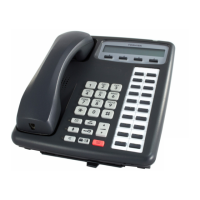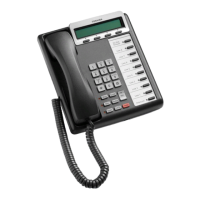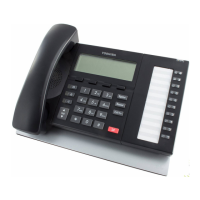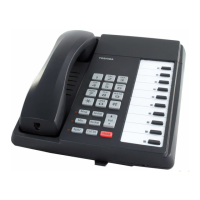DK40 Installation
TBSU Two-circuit ISDN BRI Interface Unit
2-44
Strata DK40 I&M Manual Spring 1999
Refer to the Strata DK40 Programming Manual or DK Library CD-Rom for more details.
TBSU “TE” Mode Facilities
The TE function conforms to ETSI ISDN Standards and has been tested and approved to
CTR3. It is designed to operate in “Point-to-Point” mode only and has a fixed TEI value of
“0” (zero). The interface is designed to be permanently active, at layer 2, after initial
installation. (i.e. The TBSU circuits will keep the Data Link Layer active by exchanging
“RR” frames). The reason for this is that if the DK40 needs to use the BRA circuit to provide
the system timing source so the physical layer must be maintained.
Bearer Service Handling
Incoming calls to a Digital or Electronic Key Telephone or a standard telephone device will
only be accepted if the Bearer Service is Speech or 3.1kHz. Outgoing calls from a Digital or
Electronic Key Telephone or a standard telephone device can be programmed to request
either Speech or 3.1kHz Audio Bearer Services.
Note
If modems are connected to standard telephone ports, any calls made from and to
those ports must have a 3.1kHz Bearer Service.
Supplementary Services
The following supplementary services are supported:
◆ CLIP - Calling Line Presentation
◆ COLP - Connected Line Presentation
◆ DDI - Direct Dialling In
◆ SUB - Sub Addressing sending and receiving
If the DK40 system receives Sub-Address information it is transparently passed onto the NT
type ports or ignored if the call destination is a Digital or Electronic Key Telephone, or a
standard telephone/device.
.
Figure 2-23 TBSU to NT1 Point-to-point Connection
TBSU
TE-Circuit
Switch in
100-ohm TR
using RBSU
option switch.
RJ-45
Pinout (TBSU - BRI Jack)
TBSU NT!
Network
BRI-line
Jack
NT-1
Switch
in 100-ohm
TR.
T is an ISDN standard
reference point.
Note:
BRI
(Four-wire)
T
BRI
(Two-wire)
Demarcation Point
3
6
4
5
3
6
4
5
RX
RX
TX
TX
RX/TX
4
5
RJ-45
Pinout (NT1 - S/T Jack)

